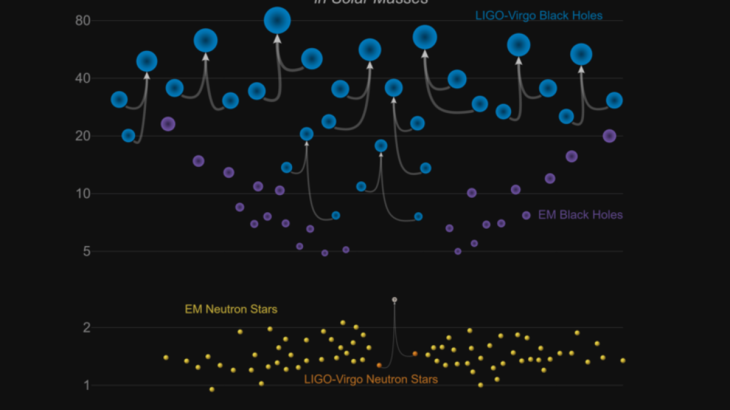Four Black Hole Collisions, One Of Which Is The Biggest One Ever Recorded By Physicists
Parvati Misra - Dec 09, 2018

Four occurrences of black hole collisions and transmitting their gravitational waves upon Earth, including the largest one ever recorded to this day.
- Scientists Research Black Holes In A Bid To Build Quantum Teleporter
- Scientist Team Behind First Ever Image Of A Black Hole Wins $3 Million Breakthrough Prize
- NASA Released A New Black Hole Simulation And It's Mesmerizing
Four occurrences of black hole collisions and transmitting their gravitational waves upon Earth were spotted by physicists, one of those collisions is the largest one ever recorded to this day.
With the advancement of technology, black hole collisions have been common amongst us with relative regularity. Individual black hole collisions are not the headline anymore – alternatively, astronomy now face the period of which gravitational waves are merely tools for understanding the universe, and the real breakthrough can be derived from the observations of gravitational events.
The Virgo collaborations and Laser Interferometer Gravitational Wave Observatory (LIGO) have commenced to cataloging gravitational occurrences to tell how frequently these events occur and their causes.

Let’s have a brief summary: Einstein’s general theory of relativity anticipates that particular universal events can produce energy from mass and in the process transmit gravitational waves or spacetime shaped ripples which travel at light speed.
The mile-plus-long detectors of LIGO, one in Louisiana, one in Washington, and Virgo detector located in Italy seek the signal using interferometers (a method of collecting interference patterns formed by waves to measure the characteristics of the waves themselves). Basically, they separate and merge the laser beam, which shines onto the detector. The detected gravitational wave will cause the laser beams to go in and out of phase with one another. Then, the signal makes a vibration which is smaller than the width of a proton.
What happens when two black holes collide? In short, when they collide, the two then merge into a larger black hole while in the process releasing a huge amount of energy that transmits as gravitational waves.
Researchers analyzed the data of Virgo and LIGO for those events and discovered four new collisions that took place in summer 2017. The results of these collisions are black holes scaling minimum at 17.8 times or maximum at 80.3 times the Sun’s mass, which occur in the distance range from approximately 1.044 to 8.97 billion of light years away.
The event increased the amount of known black holes collisions to 10 measurements and the amount of known neutron stars collisions to one measurement. It is estimated that 53 black hole merges occur each year in the period of every cubic gigaparsec of the universe. The results of the research were published in a newspaper over the weekend.
According to the press release, physicists implemented three individual analyses to figure out the events presented in the aforementioned data. Furthermore, 14 more potential collisions were found in two of the three analyses.
Among the found collisions, one led to the formation of the black hole weighing 80.3 times the mass of the Sun, which caught the attention of the scientists.
It is beyond expectation that stars collapsing could produce the black holes weighing more than 45 solar masses, disclosed by the assistant professor at the University of Florida, Imre Bartos. Additionally, it seemed to rotate rapidly. Perhaps this abnormal observation derived from the combination of two black holes, and the second combination of that with the third black hole in a black hole-rich environment. The aforementioned even appear to reside in our galaxy.
However, that has not been proven at the moment. Bartos stated that they would know better about how frequent those ‘double’ mergers happen when more events coming.
Better determinations can only be given by researchers when more observations of gravitational waves are done, which could tell us more about the conditions these collisions occur and how the black holes travel closer to each other prior.
However, there are others to be thrilled about, scientists may be given the approval to research new particles, axions for example. Moreover, the collisions of black holes are not the only thing that generates gravitational waves; the collisions of neurons stars also produce the same thing. Though there aren’t any neuron-stars collisions found yet, a new method to figure out how rapidly the universe is expanding could be found once we have a large catalog of neutron-stars collisions.
Although observational gravitational wave astronomy only began in 2015, it has been exciting times for them recently. More advanced detectors will soon help to verify the discoveries, and more can be studied from better data. Data collecting will take place soon in spring at Virgo and LIGO.
Featured Stories

Features - Jul 01, 2025
What Are The Fastest Passenger Vehicles Ever Created?

Features - Jun 25, 2025
Japan Hydrogen Breakthrough: Scientists Crack the Clean Energy Code with...

ICT News - Jun 25, 2025
AI Intimidation Tactics: CEOs Turn Flawed Technology Into Employee Fear Machine

Review - Jun 25, 2025
Windows 11 Problems: Is Microsoft's "Best" OS Actually Getting Worse?

Features - Jun 22, 2025
Telegram Founder Pavel Durov Plans to Split $14 Billion Fortune Among 106 Children

ICT News - Jun 22, 2025
Neuralink Telepathy Chip Enables Quadriplegic Rob Greiner to Control Games with...

Features - Jun 21, 2025
This Over $100 Bottle Has Nothing But Fresh Air Inside

Features - Jun 18, 2025
Best Mobile VPN Apps for Gaming 2025: Complete Guide

Features - Jun 18, 2025
A Math Formula Tells Us How Long Everything Will Live

Features - Jun 16, 2025


Comments
Sort by Newest | Popular